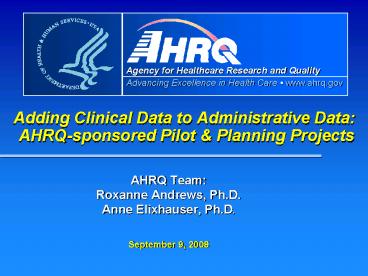Adding Clinical Data to Administrative Data: AHRQsponsored Pilot - PowerPoint PPT Presentation
1 / 23
Title:
Adding Clinical Data to Administrative Data: AHRQsponsored Pilot
Description:
BNP. Calcium. C-Reactive Protein. Creatine Kinase (CPK) Creatine Kinase MB. Creatinine ... Pro-BNP. Sodium. Troponin I. Troponin T. Urea Nitrogen (BUN) ... – PowerPoint PPT presentation
Number of Views:39
Avg rating:3.0/5.0
Title: Adding Clinical Data to Administrative Data: AHRQsponsored Pilot
1
Adding Clinical Data to Administrative Data
AHRQ-sponsored Pilot Planning Projects
- AHRQ Team
- Roxanne Andrews, Ph.D.
- Anne Elixhauser, Ph.D.
- September 9, 2008
2
Outline
- Rationale for AHRQ contracts to add clinical data
to administrative data - Overview of AHRQ-sponsored projects
- First-year activities of pilot projects
3
Limitations of Administrative Data for Quality
Measurement
- Lack clinically important information
- Limited to ICD-9-CM diagnosis codes
- Often do not include present on admission (POA)
indicator for diagnoses - Questions for hospital-specific reporting
- Inadequate for risk adjustment to predict
individual patients risk of mortality - Concern about penalizing providers with the
sickest patients
4
Rationale for Adding Clinical Data
- AHRQ-sponsored study showed adding a few clinical
data elements significantly improves quality
assessment using administrative data - Important, cost-effective, additions
- POA
- Lab values (numeric) on admission
- (Potentially) vital signs
5
AHRQ Contracts to Add Clinical Data to Statewide
Administrative Data
- Purpose
- Jumpstart the enhancement of administrative data
- Expand data capacities for statewide data
organizations participating in HCUP - Solicited proposals for two types of contracts
- In-depth pilots
- To add or link hospital clinical information to
administrative data - Sept. 2007 Sept. 2009
- Planning contracts
- For organizations not yet ready to engage in
pilots - But seek to enhance their administrative data
- Sept. 2007 Mar. 2009
6
Awards to Statewide Data Organizations
- Pilots
- Florida Center for Health Information and Policy
Analysis, Agency for Health Care Administration - Minnesota Hospital Association
- Virginia Health Information
- Planning
- Washington Center for Health Statistics, State
Department of Health
7
Objectives of Pilots
- Establish feasibility of linking clinical and
administrative data - Develop reproducible approach
- Set the stage for integrating clinical and
administrative data streams in the future
8
Project Requirements
- Identify and select clinical data elements to add
to administrative data - Translate clinical data from electronic format
- Electronically transfer data from at least five
hospitals to the data organization - Process data into a multi-hospital database
- Collaborate with stakeholders
- Engage in peer-to-peer learning, information
sharing, dissemination
8
9
First Years Activities
- Develop Final Implementation Plan
- Recruit hospitals
- Develop data collection method
- Begin data collection
- Participate in peer learning network
disseminate lessons learned
9
10
Recruit Hospitals
- Build the business case
- Advantages of adding clinical data to admin data
- Incentives for participation, e.g.
- Data quality feedback
- Hospital quality feedback reports
- Assess hospital readiness
- Electronic lab data
- LOINC coding
- HL-7 transmission
10
11
Recruitment Very Successful
12
http//www.fhin.net/FHIN/HITinitiatives/AHRQadding
ClinData.shtml
13
http//www.mnhospitals.org/index/ahrq-project
13
14
http//www.vhi.org/hybriddata.asp
14
15
Develop Data Collection Method
- Select data elements to be collected
- POA
- Lab data elements
- Linking data elements
- Develop standard data submission format
- LOINC coding of lab names
- Develop methods for transmitting data
- HL7 to be used by some Minnesota hospitals
- HL7 fields to be used in Virginia
- Instruct hospitals on how to submit data
16
Types of Lab Tests to be Included Chemistry
- AST
- Albumin
- Alkaline Phosphatase
- Amylase
- Bicarbonate
- Bilirubin Total
- BNP
- Calcium
- C-Reactive Protein
- Creatine Kinase (CPK)
- Creatine Kinase MB
- Creatinine
- Glucose
- Lactic Acid
- Potassium
- Pro-BNP
- Sodium
- Troponin I
- Troponin T
- Urea Nitrogen (BUN)
17
Types of Lab Tests to be Included Other
- BLOOD GAS
- Arterial O2 Saturation
- Arterial pCO2
- Arterial pH
- Arterial pO2
- Base Excess
- Bicarbonate
- FIO2
- HEMATOLOGY
- Hemoglobin
- INR
- Neutrophil Bands
- Partial Thromboplastin Time
- Platelet Count
- Prothrombin Time
18
Type Information To Be Collected on Lab Tests
- LOINC code for lab test name
- Observation value (lab result)
- Observation unit of measure
- Date/time of observation
19
Participate in Peer Learning Network
- Monthly conference calls with other pilot and
planning state data organizations - Document sharing
- California and the Veterans Administration have
joined to share their knowledge on similar
activities
20
Sharing Lessons Learned with Other Organizations
- Interim Information on HCUP-US
- Implementation Plans
- Project summaries
- Links to project websites
- www.hcup-us.ahrq.gov/reports/clinicaldata.jsp
21
http//www.hcup-us.ahrq.gov/reports/clinicaldata.j
sp
21
22
Future Activities
- Complete Projects
- Collect clinical data and link with
administrative data - Produce multi-hospital data set
- Assess data quality
- Use data to produce hospital-level reports on
quality - Provide hospitals feedback
- Final Lessons
- Final report from each site
- Synthesis of lessons across sites by Thomson
Reuters National Academy for State Health
Policy (NASHP)
22
23
Contact information
- Roxanne Andrews
- roxanne.andrews_at_ahrq.hhs.gov
- 301-427-1403
- Anne Elixhauser
- anne.elixhauser_at_ahrq.hhs.gov
- 301-427-1411































